PESTS AND DISEASES OF FORESTRY IN NEW ZEALAND
Eucalyptus variegated beetle creates concern for eucalypt growers
Toni Withers, Rebecca McDougal, Michelle Harnett and Tara Murray, New Zealand Tree Grower Magazine May 2018.
Annoying Australians are over here and eating ‘our’ eucalypt trees. Seven different tortoise beetles, named because their round bodies resemble a tortoise, have arrived in New Zealand and have been making pests of themselves for more than 100 years.
| Year of arrival | Identity | Common name | Feeds on |
|---|---|---|---|
| 1916 | Paropsis charybdis | Eucalyptus tortoise beetle | Symphyomyrtus eucalypts |
| 1976 | Trachymela sloanei | small Eucalyptus tortoise beetle | Symphyomyrtus eucalypts |
| 1976 | Pyrgoides sp.6 | leaf beetle | Acacia spp. |
| 1992 | Trachymela catenata | small Eucalyptus tortoise beetle | Symphyomyrtus eucalypts |
| 1996 | Dicranosterna semipunctata | blackwood tortoise beetle | Blackwood Acacia melanoxylon |
| 2012 | Paropsisterna beata | Eucalyptus leaf beetle | Symphyomyrtus eucalypts |
| 2016 | Paropsisterna variicollis | Eucalyptus variegated beetle | Symphyomyrtus eucalypts |
The most recent arrival is Paropsisterna variicollis, the eucalyptus variegated beetle. Its presence was noted in Hawke’s Bay in 2016. A fast life cycle, at least three generations a year, clustered larval feeding, a high reproductive output, and the fact that it feeds on both juvenile and adult leaves means eucalyptus variegated beetle is an unwelcome incursion. Furthermore, it is a beetle with the potential to affect a wide range of eucalypts, and where conditions support multiple generations each year, it may have potential to cause repeated defoliation and affect growth.
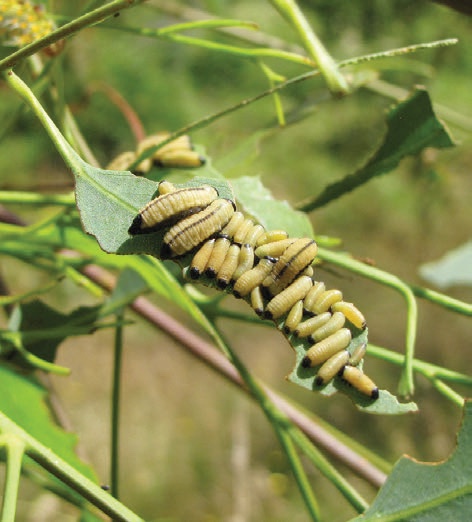
Eucalyptus variegated beetle has spread throughout Hawke’s Bay and in 2018 moved to north east Hawke’s Bay, to Taihape in the west and Masterton in the south. The spread of the pest can be tracked on NatureWatch NZ and we urge all readers to photograph and report suspected sightings at www.naturewatch.org.nz.
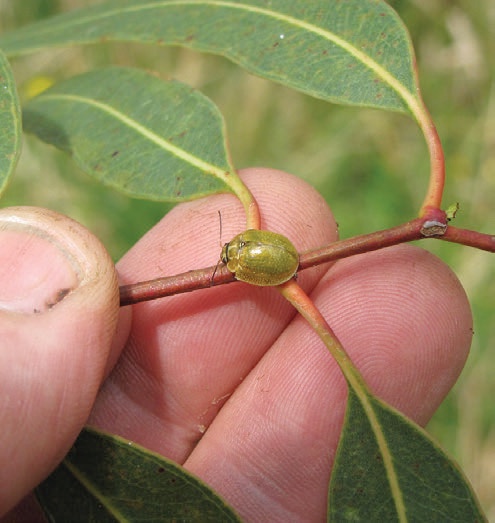
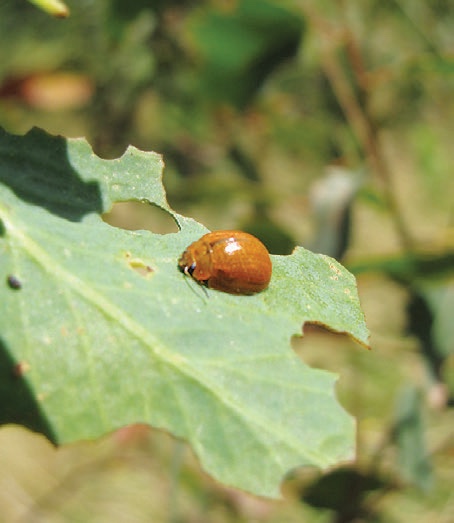
Which tortoise beetle has the worst effect?
The eucalyptus tortoise beetle P. charybdis has long held the title of tortoise beetle with the greatest economic effect on New Zealand. It limits the growth of eucalypt species in the sub-genus Symphyomyrtus, particularly E. camaldulensis river red gum, E. viminalis ribbon gum, E. globulus blue gum and E. nitens. It and has been the focus of four biological control introductions since the 1970s. It is also the only production forestry insect pest controlled by repeated aerial sprays in attempts to maintain the growth rate of E. nitens plantations. Eucalyptus tortoise beetle is also a significant defoliator of E. quadrangulata, one of the species of interest to the NZ Dryland Forests Initiative.
Unfortunately, the known biology of eucalyptus variegated beetle suggests it is a strong contender to knock P. charybdis out of first place. Although the most widely grown eucalypts such as E. nitens have not yet been assessed, two defoliation assessments of Dryland Forests Initiative plantings showed eucalyptus variegated beetle had caused moderate to severe damage to a level which is likely to affect tree growth and height.
The species most affected were E. tricarpa, E. bosistoana, E. quandrangulata, E. argophloia, and E. camaldulensis. Only one of the Dryland Forests Initiative’s top five species, E. globoidea white stringybark, appears to be less preferred by eucalyptus variegated beetle. Luckily, the literature suggests monocalypts are less palatable to this beetle, so E. fastigata plantations may be less affected. In addition, it is encouraging that some individual family lines within each of the Dryland Forests Initiative species assessed showed only limited attack. Because reducing pest risk is a recognised objective of the Dryland Forests Initiative breeding programme, selecting for the most insect resistant or tolerant lines will be incorporated into the durable eucalypt species improvement trials as shown in the table below.
| Species in order of importance to Drylands Forests Initiative | Common name | Susceptibility to eucalyptus variegated beetle | Susceptibility to eucalyptus tortoise beetle |
|---|---|---|---|
| E. argophloia | Western white gum | Moderate | Moderate |
| E. bosistoana | Coastal grey box | Highly susceptible | Moderate |
| E. globoidea | White stringybark | Low-moderate | Low |
| E. quadrangulata | White-topped box gum | Low | Highly susceptible |
| E. tricarpa | Red ironbark | Moderate | Low |
| E. camaldulensis | River red gum | Moderate | Highly susceptible |
| E. cladocalyx | Sugar gum | Low-moderate | Low |
| E. longifolia | Woollybutt | Moderate | Moderate |
| E. macrorhyncha | Red stringybark | Low | Low |
| E. eugenioides | Stringybark | Moderate | Low |
These early assessments suggest eucalyptus variegated beetle has the potential to affect some commercial eucalypt species. Therefore, further monitoring and impact assessments are urgently required.
Options for long term control of tortoise beetles
Two existing biological control agents introduced to control P. charybdis also attack and kill the eggs of eucalyptus variegated beetle. These are the egg parasitoid Enoggera nassaui and the predatory southern ladybird Cleobora mellyi. However, they have not been effective at halting the rapid population growth of eucalyptus variegated beetle observed in the Hawke’s Bay.
Field work this year showed E. nassaui managed to parasitise 50 to 75 per cent of P. charybdis egg batches, but parasitism rates for eucalyptus variegated beetle are only one to three per cent. Parasitoids which do emerge are small, only two thirds of the size of those that emerge from P. charybdis eggs.
Female E. nassaui parasitoids are known to be reluctant to attack eucalyptus variegated beetle eggs, stinging only three an hour compared to nine an hour when given P. charybdis eggs. This is thought to be due the outside of the eucalyptus variegated beetle egg being covered in small sharp spines which put the parasitoid off. This is bad news which suggests E. nassaui is not a good long-term solution for eucalyptus variegated beetle.
The southern ladybird does predate eucalyptus variegated beetle eggs and young larvae, but we have no data yet to suggest how effective it may be. To maintain high population levels in forests, the ladybirds need a regular and varied supply of insects throughout the season.
Alternative biological control agents will be needed to support long term sustainable control. Scion has taken the first step in this process by undertaking molecular analysis to confirm the identification and area of origin of eucalyptus variegated beetle. This was carried out to ensure biological control agents can be found from the same geographic region. Mitochondrial DNA and the genitalia of eucalyptus variegated beetle from New Zealand were compared to specimens from Tasmania and mainland Australia. There are many similar-looking tortoise beetles to eucalyptus variegated beetle and the taxonomy is still poorly defined.
We tested several closely related species from different regions, and can confirm that the New Zealand species is indeed P. variicollis but we cannot say which region of Australia our population originated from. Individuals genetically identical to those in New Zealand were found in Tasmania, Victoria, ACT and southern New South Wales. Molecular tests are continuing to increase our knowledge and narrow the point of origin further.
Natural enemies
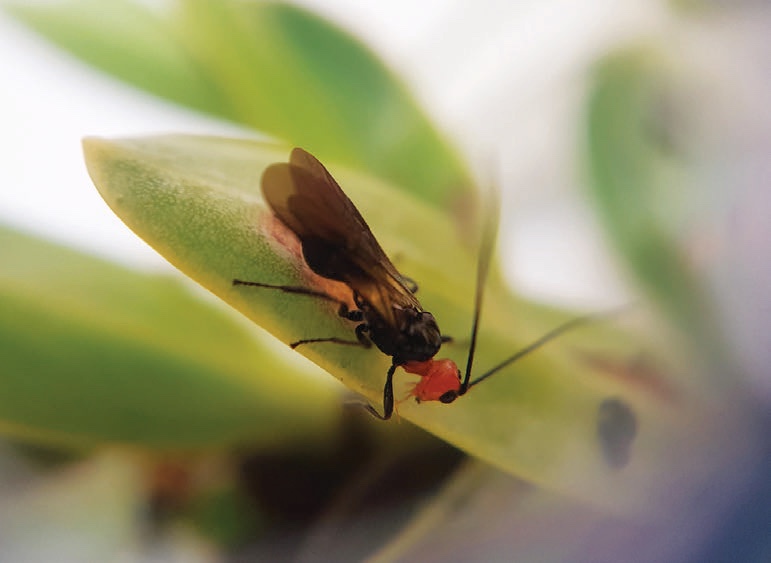
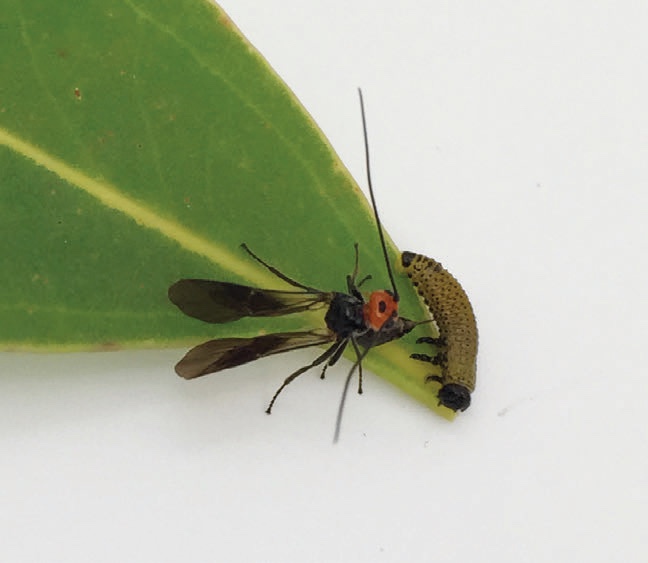
Clues from eucalypt forests in Tasmania may help us locate biological control agents. Since 2012 Scion has been collaborating with Dr Geoff Allen from the University of Tasmania to investigate natural enemies of P. charybdis. This work has been supported by the Sustainable Farming Fund grant, eucalypt growers and the NZFFA.
Widespread collection and rearing of parasitoids from E. nitens plantations in Tasmania has revealed a number of braconid parasitoid wasps attacking tortoise beetles. One parasitoid has been studied in depth by Geoff and his students. Shiny black with a red head, the wasp attacks the spring generation of P. charybdis larvae during December. Parasitoid taxonomists from the United States have recently named this species. Scion will be applying to New Zealand’s Environmental Protection Authority in 2018 for permission to introduce Eadya daenerys to act as a biological control agent against P. charybdis in New Zealand.
Will Eadya daenerys also be a control?
Eadya daenerys has, unfortunately, never been reared from eucalyptus variegated beetle. However, another species referred to as Eadya annleckiei, distinguishable by a black head with orange mouthparts, will complete its lifecycle on eucalyptus variegated beetle and two other related tortoise beetle species in Tasmania. A separate programme of research will be required to evaluate the potential of Eadya annleckiei in New Zealand before an application can be made to the Environmental Protection Authority to introduce this larval parasitoid.
Additional natural enemies that are specific to eucalyptus variegated beetle are likely to be required as eucalyptus variegated beetle has multiple generations each year in New Zealand and Eadya annleckiei only controls the spring generation. Ideally, we would like to find a parasitoid which could be present throughout the entire breeding season and attack all the generations of the pest. This might be an egg parasitoid, or even better, a combination of egg and larval-specific parasitoids.
What is needed for the future?
Scion and the University of Canterbury have begun research to assess the effects of eucalyptus variegated beetle and identify options for biological control. However, without industry support, a solution could be a long time coming. Funds to support long-term pest management research of new organisms which have established in New Zealand are generally accessible by using the Sustainable Farming Fund. The process requires a contribution from industry and can fund up to three- year programmes of research. This limited time frame is a big constraint when researching classical biological control options for insect pests. Therefore, a two-phase approach may be necessary.
Phase one would be to undertake dose-response and field trials to establish spray regimes to protect commercial eucalypt plantations in the interim before sustainable long-term solutions are available. Simultaneously we would conduct a search for biocontrol agents of eucalyptus variegated beetle in Australia and assess C. mellyi in the field in New Zealand.
Phase two would be to conduct host testing trials on the target biocontrol agents identified in the first phase and then apply to the Environmental Protection Authority to release suitable agents in New Zealand. Toni Withers would be interested in speaking to any individuals and companies who have views on this proposal – email toni.withers@scionresearch.com.
If you would like to contribute to pre-application consultation on the release of Eadya daenerys as a biological control of eucalyptus tortoise beetle P. charybdis, please send Scion your feedback via an on-line consultation form accessible on www.scionresearch.com/paropsis
Toni Withers is a senior Scion forest entomologist. Rebecca McDougal is a molecular forest pathologist and Michelle Harnett, science communicator for Scion. Tara Murray is senior lecturer in biosecurity and pest management at the University of Canterbury School of Forestry.



